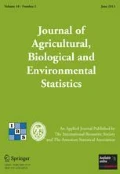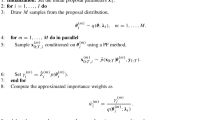Abstract
In statistical ecology, state-space models are commonly used to represent the biological mechanisms by which population counts—often subdivided according to characteristics such as age group, gender or breeding status—evolve over time. As the counts are only noisily or partially observed, they are typically not sufficiently informative about demographic parameters of interest and must be combined with additional ecological observations within an integrated data analysis. Fitting integrated models can be challenging, especially if the constituent state-space model is nonlinear/non-Gaussian. We first propose an efficient particle Markov chain Monte Carlo algorithm to estimate demographic parameters without a need for linear or Gaussian approximations. We then incorporate this algorithm into a sequential Monte Carlo sampler to perform model comparison. We also exploit the integrated model structure to enhance the efficiency of both algorithms. The methods are demonstrated on two real data sets: little owls and grey herons. For the owls, we find that the data do not support an ecological hypothesis found in the literature. For the herons, our methodology highlights the limitations of existing models which we address through a novel regime-switching model. Supplementary materials accompanying this paper appear online.




Similar content being viewed by others
References
Abadi, F., Gimenez, O., Arlettaz, R., and Schaub, M. (2010a). An assessment of integrated population models: Bias, accuracy, and violation of the assumption of independence. Ecology, 91(1):7–14.
Abadi, F., Gimenez, O., Ullrich, B., Arlettaz, R., and Schaub, M. (2010b). Estimation of immigration rate using integrated population models. Journal of Applied Ecology, 47(2):393–400.
Andrieu, C., Doucet, A., and Holenstein, R. (2010). Particle Markov chain Monte Carlo methods. Journal of the Royal Statistical Society: Series B (Statistical Methodology), 72(3):269–342. With discussion.
Bernardo, J. M. and Smith, A. F. M. (2009). Bayesian Theory. Wiley.
Besbeas, P., Borysiewicz, R. S., and Morgan, B. J. T. (2009). Completing the Ecological Jigsaw. In Modeling Demographic Processes in Marked Populations, pages 513–539. Springer.
Besbeas, P., Freeman, S. N., Morgan, B. J. T., and Catchpole, E. A. (2002). Integrating mark-recapture-recovery and census data to estimate animal abundance and demographic parameters. Biometrics, 58(3):540–547.
Besbeas, P. and Morgan, B. J. T. (2012). A threshold model for heron productivity. Journal of Agricultural, Biological, and Environmental Statistics, 17(1):128–141.
Breed, G., Costa, D., Jonsen, I., Robinson, P., and Mills-Flemming, J. (2012). State-space methods for more completely capturing behavioral dynamics from animal tracks. Ecological Modelling, 235:49–58.
Brooks, S. P., King, R., and Morgan, B. J. T. (2004). A Bayesian approach to combining animal abundance and demographic data. Animal Biodiversity and Conservation, 27(1):515–529.
Buckland, S. T., Newman, K. B., Fernandez, C., Thomas, L., and Harwood, J. (2007). Embedding population dynamics models in inference. Statistical Science, 22(1):44–58.
Carpenter, B., Gelman, A., Hoffman, M. D., Lee, D., Goodrich, B., Betancourt, M., Brubaker, M., Guo, J., Li, P., and Riddell, A. (2017). Stan: A probabilistic programming language. Journal of Statistical Software, 76(1).
Chopin, N. (2002). A sequential particle filter method for static models. Biometrika, 89(3):539–552.
Chopin, N., Jacob, P. E., and Papaspiliopoulos, O. (2013). \(\text{ SMC }^{2}\): An efficient algorithm for sequential analysis of state space models. Journal of the Royal Statistical Society: Series B (Statistical Methodology), 75(3):397–426.
Christen, J. A. and Fox, C. (2005). Markov chain Monte Carlo using an approximation. Journal of Computational and Graphical Statistics, 14(4):795–810.
de Valpine, P., Turek, D., Paciorek, C. J., Anderson-Bergman, C., Lang, D. T., and Bodik, R. (2017). Programming with models: Writing statistical algorithms for general model structures with NIMBLE. Journal of Computational and Graphical Statistics, 26(2):403–413.
Del Moral, P. (1996). Nonlinear filtering: Interacting particle solution. Markov Processes and Related Fields, 2(4):555–580.
Del Moral, P., Doucet, A., and Jasra, A. (2006). Sequential Monte Carlo samplers. Journal of the Royal Statistical Society: Series B, 68(3):411–436.
Doucet, A. and Johansen, A. M. (2011). A tutorial on particle filtering and smoothing: Fifteen years later. In Crisan, D. and Rozovskii, B., editors, The Oxford Handbook of Nonlinear Filtering, Oxford Handbooks, chapter 24, pages 656–704. Oxford University Press.
Drovandi, C. C. and McCutchan, R. A. (2016). Alive \(\text{ SMC }^{2}\): Bayesian model selection for low-count time series models with intractable likelihoods. Biometrics, 72(2):344–353.
Duan, J.-C. and Fulop, A. (2015). Density-tempered marginalized sequential Monte Carlo samplers. Journal of Business & Economic Statistics, 33(2):192–202.
Dupuis, J. A. (1995). Bayesian estimation of movement and survival probabilities from capture-recapture data. Biometrika, 82(4):761–772.
Gilks, W. R., Thomas, A., and Spiegelhalter, D. J. (1994). A language and program for complex Bayesian modelling. Journal of the Royal Statistical Society. Series D (The Statistician) , 43(1):169–177.
Golightly, A., Henderson, D. A., and Sherlock, C. (2015). Delayed acceptance particle MCMC for exact inference in stochastic kinetic models. Statistics and Computing, 25(5):1039–1055.
Green, P. J. (1995). Reversible jump Markov chain Monte Carlo computation and Bayesian model determination. Biometrika, 82(4):711–732.
Kalman, R. E. (1960). A new approach to linear filtering and prediction problems. Journal of Basic Engineering, 82(1):35–45.
Kass, R. E. and Raftery, A. E. (1995). Bayes factors. Journal of the American Statistical Association, 90(430):773–795.
King, R. (2011). Statistical Ecology. In Brooks, S., Gelman, A., Jones, G., and Meng, X.-L., editors, Handbook of Markov Chain Monte Carlo, chapter 17, pages 410–447. CRC Press.
King, R. (2012). A review of Bayesian state-space modelling of capture-recapture-recovery data. Interface Focus, 2:190–204.
King, R. (2014). Statistical ecology. Annual Review of Statistics and its Application, 1(1):401–426.
King, R., Brooks, S., Mazzetta, C., Freeman, S., and Morgan, B. (2008). Identifying and diagnosing population declines: A Bayesian assessment of lapwings in the UK. Journal of Royal Statistical Society: Series C, 57(5):609–632.
Knape, J. and de Valpine, P. (2012). Fitting complex population models by combining particle filters with Markov chain Monte Carlo. Ecology, 93(2):256–263.
Lindley, D. V. (1957). A statistical paradox. Biometrika, 44(1/2):187–192.
McClintock, B. T., King, R., Thomas, L., Matthiopoulos, J., McConnell, B. J., and Morales, J. M. (2012). A general discrete-time modeling framework for animal movement using multi-state random walks. Ecological Monographs, 82(3):335–349.
McCrea, R. S. and Morgan, B. J. T. (2014). Analysis of Capture-Recapture Data. CRC Press.
Millar, R. B. and Meyer, R. (2000). Non-linear state space modelling of fisheries biomass dynamics by using Metropolis-Hastings within-Gibbs sampling. Journal of the Royal Statistical Society: Series C, 49(3):327–342.
Morales, J., Haydon, D., Frair, J., Holsiner, K., and Fryxell, J. (2004). Extracting more out of relocation data: Building movement models as mixtures of random walks. Ecology, 85(9):2436–2445.
Newman, K. B. (1998). State-space modelling of animal movement and mortality with application to salmon. Biometrics, 54:1290–1314.
Newman, K. B., Buckland, S. T., Morgan, B. J. T., King, R., Borchers, D. L., Cole, D., Besbeas, P. T., Gimenez, O., and Thomas, L. (2014). Modelling Population Dynamics: Model Formulation, Fitting and Assessment using State-space Methods. Springer.
Nishimura, A., Dunson, D., and Lu, J. (2017). Discontinuous Hamiltonian Monte Carlo for models with discrete parameters and discontinuous likelihoods. ArXiv e-prints arXiv:1705.08510.
Parslow, J., Cressie, N., Campbell, E. P., Jones, E., and Murray, L. (2013). Bayesian learning and predictability in a stochastic nonlinear dynamical model. Ecological Applications, 23(4):679–698.
Peters, G. W., Hosack, G. R., and Hayes, K. R. (2010). Ecological non-linear state space model selection via adaptive particle Markov chain Monte Carlo (AdPMCMC). ArXiv e-prints arXiv:1005.2238.
Plummer, M. (2003). JAGS: A program for analysis of Bayesian graphical models using Gibbs sampling. In Proceedings of the 3rd International Workshop on Distributed Statistical Computing. Vienna, Austria.
Pooley, C. and Marion, G. (2018). Bayesian model evidence as a practical alternative to deviance information criterion. Royal Society Open Science, 5(3):171519.
Royle, J. A. (2008). Modeling individual effects in the Cormack-Jolly-Seber model: A state-space formulation. Biometrics, 64(2):364–370.
Schaub, M., Ullrich, B., Knötzsch, G., Albrecht, P., and Meisser, C. (2006). Local population dynamics and the impact of scale and isolation: A study on different little owl populations. Oikos, 115(3):389–400.
Sherlock, C., Thiery, A., and Golightly, A. (2015). Efficiency of delayed-acceptance random walk Metropolis algorithms. ArXiv e-prints arXiv:1506.08155.
Spiegelhalter, D. J., Best, N. G., Carlin, B. P., and Van Der Linde, A. (2002). Bayesian measures of model complexity and fit. Journal of the Royal Statistical Society: Series B (Statistical Methodology), 64(4):583–639.
Zhou, Y., Johansen, A. M., and Aston, J. A. D. (2016). Towards automatic model comparison: An adaptive sequential Monte Carlo approach. Journal of Computational and Graphical Statistics, 25(3):701–726.
Acknowledgements
This work was supported by The Alan Turing Institute under the EPSRC Grant EP/N510129/1. AB and AF were funded by a Leverhulme Trust Prize.
Author information
Authors and Affiliations
Corresponding author
Additional information
Publisher's Note
Springer Nature remains neutral with regard to jurisdictional claims in published maps and institutional affiliations.
Electronic supplementary material
Below is the link to the electronic supplementary material.
13253_2018_349_MOESM1_ESM.pdf
Web Appendices and Figures, referenced in Sections 3--6, are available at [link to supplementary pdf file goes here]. All data and C++/R code necessary for reproducing the results can be found at https://github.com/AxelFinke/monte-carlo-rcpp. (345KB)
Rights and permissions
About this article
Cite this article
Finke, A., King, R., Beskos, A. et al. Efficient Sequential Monte Carlo Algorithms for Integrated Population Models. JABES 24, 204–224 (2019). https://doi.org/10.1007/s13253-018-00349-9
Received:
Accepted:
Published:
Issue Date:
DOI: https://doi.org/10.1007/s13253-018-00349-9




